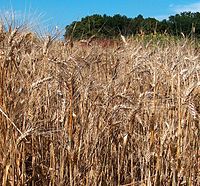
Photo from wikipedia
Due to the accumulation of various useful traits over evolutionary time, emmer wheat (Triticum turgidum subsp. dicoccum and dicoccoides, 2n = 4x = 28; AABB), durum wheat (T. turgidum subsp. durum, 2n = 4x = 28; AABB), T.… Click to show full abstract
Due to the accumulation of various useful traits over evolutionary time, emmer wheat (Triticum turgidum subsp. dicoccum and dicoccoides, 2n = 4x = 28; AABB), durum wheat (T. turgidum subsp. durum, 2n = 4x = 28; AABB), T. timopheevii (2n = 4x = 28; AAGG) and D genome containing Aegilops species offer excellent sources of novel variation for the improvement of bread wheat (T. aestivum L., AABBDD). Here, we made 192 different cross combinations between diverse genotypes of wheat and Aegilops species including emmer wheat × Ae. tauschii (2n = DD or DDDD), durum wheat × Ae. tauschii, T. timopheevii × Ae. tauschii, Ae. crassa × durum wheat, Ae. cylindrica × durum wheat and Ae. ventricosa × durum wheat in the field over three successive years. We successfully recovered 56 different synthetic hexaploid and octaploid F2 lines with AABBDD, AABBDDDD, AAGGDD, D1D1XcrXcrAABB, DcDcCcCcAABB and DvDvNvNvAABB genomes via in vitro rescue of F1 embryos and spontaneous production of F2 seeds on the Fl plants. Cytogenetic analysis of F2 lines showed that the produced synthetic wheat lines were generally promising stable amphiploids. Contribution of D genome bearing Aegilops and the less-investigated emmer wheat genotypes as parents in the crosses resulted in synthetic amphiploids which are a valuable resource for bread wheat breeding.
Journal Title: Scientific Reports
Year Published: 2020
Link to full text (if available)
Share on Social Media: Sign Up to like & get
recommendations!